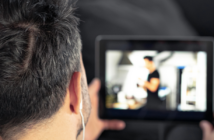There has been a lot of talk about millennials lately, so let’s talk about Generation Z for a change! Gen Z is loosely defined as anyone born since 1995. In the US, they already represent $44 billion in annual purchasing power, according to a study by ad agency sparks & honey. So it’s about time brands and entertainment companies should start looking at their interests and media behaviour.
At first glance, these digital natives might look strikingly familiar. But looks can be deceiving. For example, millennials might be digitally savvy too, but they grew up in a world without smartphones and just on the cusp of the internet boom. Most Gen Zs, however, could swipe before they even could walk or talk. Screens were always a part of their lives. While tech-savvy millennials might have two screens, the tech-innate Gen Z multi-task across five screens (TV, phone, laptop, desktop and either a tablet or some handheld gaming device).
Another difference is that Gen Z-ers tend to see the web more as a tool for getting things done, rather than a place to be discovered and become famous. That’s why they prefer Snapchat over Facebook. The self-destructing messaging app sends photos or videos directly to one friend rather than to a whole feed of Facebook followers. Gen Z is also less influenced by celebrities, but rather by influencers such as YouTube stars and peer reviews. The Deep Focus Cassandra report found that Gen Z-ers want to see “real people” in advertisements, while only 37% prefer celebrities. That might explain why 85% of them visit YouTube more than any other social site, where an average Joe can get millions of views and comments (source: Marketwired).
“Gen Z and millennials is not a thing, they’re two things,” exclaimed AwesomenessTV CEO Brian Robbins during the multi-channel network’s NewFronts presentation. And unlike most other digital players, AwesomenessTV puts more emphasis on reaching the teens and tweens of Gen Z than reaching millennials. AwesomenessTV will become the first to partner with messaging app Kik, launching a bot that combines native video and chat. In the near future, character bots will launch for AwesomenessTV’s scripted series and films to deliver companion narratives, behind-the-scenes features and alternative endings driven by audience participation (source: Adweek).
Teens use media differently from millennials today, because they saw all of millennials’ awkward over-sharing moments on Facebook. They value Snapchat, as it remembers nothing, and YouTube as it allows “average” people to make it to the big screen – unlike the types of overly aspirational characters on TV. The content marketing experts of our time are not brands, they are social media stars – personalities within YouTube, Vine, Snapchat and Instagram – who more naturally understand how to build, retain and engage an audience in new media than any big name in marketing. Therefore, brands need to think beyond the official handle. Like any music artist, an official brand handle is just a piece of the social reach. It’s the superfans or brand ambassadors that can help building reach across platforms and audiences. Achieving scale in the modern media landscape means partnering with social famous talent, or influencers, that extend your message and deliver it in a way that’s alive versus static.
Top photo: © Shutterstock / Antonio Guillem




